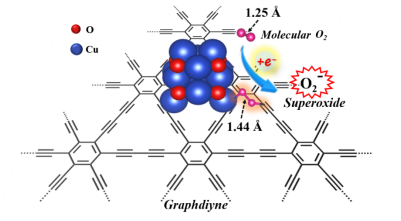Recently, Professor Guo Yanbing's research group has made important progress in the field of molecular oxygen activation to remove atmospheric pollutants. This achievement was published in the famous academic journal of the American Chemical Society in the chemical field, entitled "Neighboring sp − hybrid carbon participated molecular oxygen activation on the interface of sub nano cluster CuO/Graphiyne" (J. America Chem Soc. 2022, 144, 4942-4951). Pan Chuanqi, a 2019 doctoral student, is the first author of this paper, and Professor Guo Yanbing is the only corresponding author.
Molecular oxygen (O2) is abundant in air content (21% by volume) and is an ideal and green oxidant for some important oxidation processes, involving numerous processes from human metabolism, cancer treatment, energy conversion, and environmental remediation. However, because the Triplet state of its spin parallel electrons is too stable, it is difficult for the ground state O2 to directly participate in the reaction. Effectively activating O2 from a stable ground state to a high-energy state of reactive oxygen species has been an important scientific issue that scientists have been exploring in recent decades.
Under the support of the National Natural Science Foundation of China and the Ministry of Science and Technology's Foreign Experts Program, Guo Yanbing's research team has conducted in-depth exploration in recent years on the removal of atmospheric pollutants through molecular oxygen activation. The research group proposed the concept of "sp-carbon participation in oxygen activation" for the first time internationally and took the lead in conducting systematic research. They found that the C Å N bond regulated by metal copper can effectively activate molecular oxygen (ACS Appl. Material. Interfaces, 2018, 10, 17167-17174). At the interface of three-dimensional self-supporting Graphyne/molybdenum oxide (GDY/MoO3) composites with "sp hybrid C-O-Mo bond", electrons are transferred from the C atom of GDY to the O atom of MoO3 through the interface "sp hybrid C-O-Mo bond", which promotes the lattice oxygen activation of MoO3, thus showing excellent activity (J. Am. Chem. Soc., 2021, 143, 8720 − 8730). The research group was also invited to participate in the renowned environmental journal Environment Sci.: Nano published a Critical Review article, which systematically introduced the unique structure, physical and chemical properties of Graphyne and its composite nanomaterials and their potential application prospects in the field of environmental remediation (Environment. Sci.: Nano, 2021, 8, 1863 – 1885.)

Figure 1. Schematic diagram of molecular oxygen activation
Recently, our research group has constructed a sub nano cluster Copper(II) oxide/Graphyne catalyst through precise interface control, which was first proposed and put forward in the


